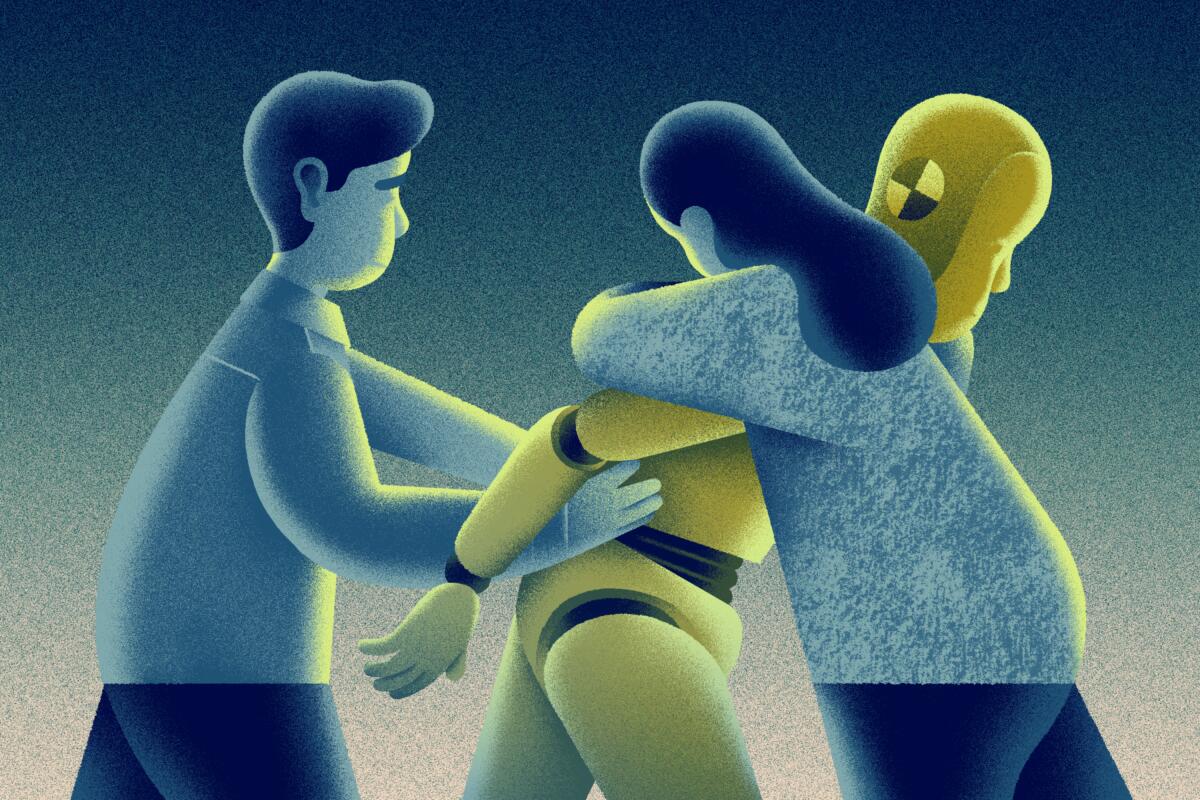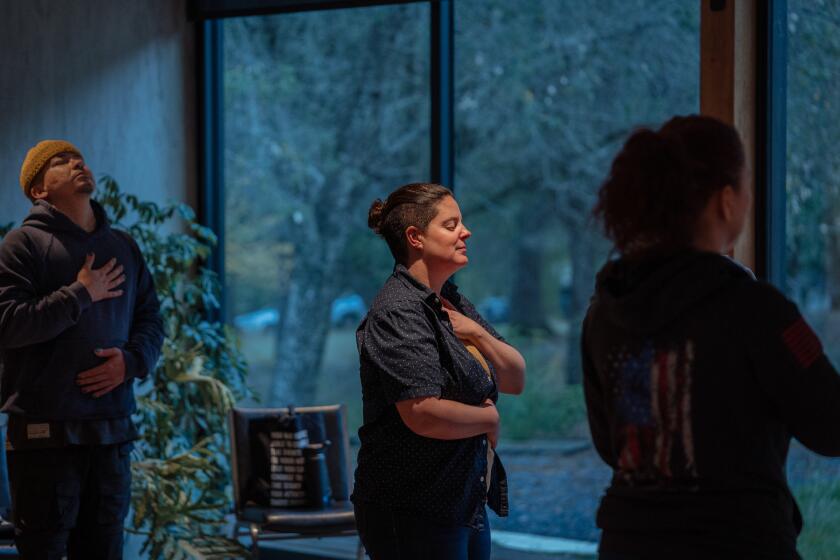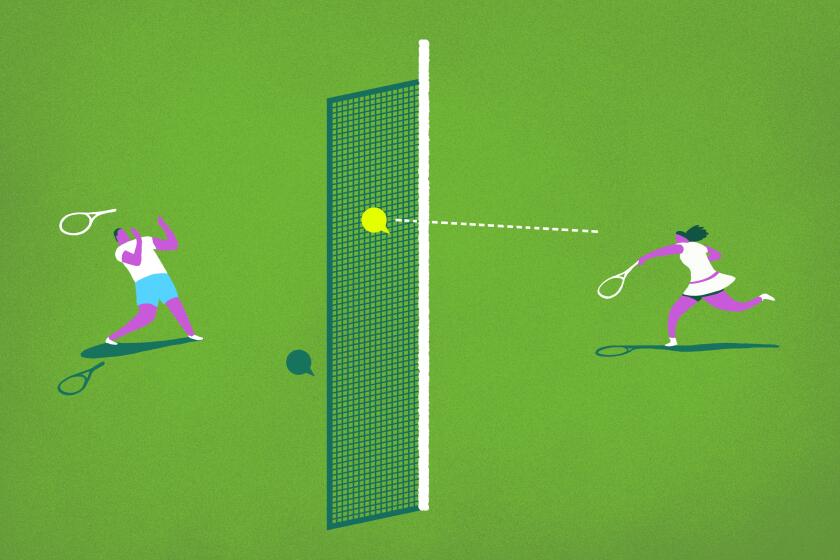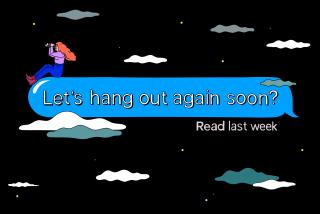Are we hugging again now? How to handle the awkwardness of greeting people

- Share via
Something surprising happened recently to Mia Schachter, a consent educator, podcaster and intimacy coordinator who founded the school Consent Wizardry. “I met a completely new person, and I put out my hand to shake hers, and she went in for a hug,” Schachter explains. “I am a hugger!” But “the total stranger with no check in — it’s too intimate!” they say. “I think that I was optimistic with COVID, as we come out of this global tragedy, that at least people will be better about boundaries, which is turning out to be not the case.”
“It’s like the Wild West again,” agrees social psychologist Tessa West, a professor at New York University and author of “Jerks at Work: Toxic Coworkers and What to Do About Them.” “During the pandemic, we went into a really awkward period where we started to just elbow each other instead of hugging. And now no one knows whether hugs are back. Now especially, we just don’t have implicit norms around these types of behaviors.”
Instead, we get the awkward dance of should-we-or-should-we-not, hugs that people don’t want and at least a few hugless folks who really wish someone had given them one. As we head back to workplaces and get ready for the holidays, it’s time to confront how we really feel about hugging — and what we’re going to do about it.
This may get a little awkward
Hugging may be a cultural norm among Americans, but when you stop to think about it, putting your arms around a relative stranger is sort of an odd thing to do. West posits that, like handshakes, hugging probably originally signaled that someone didn’t have a weapon and was safe to be around. “Now it’s kind of an appendix. We’re stuck with it even though it doesn’t have much utility,” she says.
Lisa Mirza Grotts, an etiquette expert based in San Francisco, says the problem with hugging is “there’s so much uncertainty. It makes people nervous.” She advises going with a handshake, which, despite its predicted demise due to COVID, seems to be on the way back as well. “You make quick eye contact, you shake for a few seconds and you move on. A hug can definitely be a substitute handshake, but to hug instead, you really have to know your audience.”
Of course, there’s no way to fully avoid awkwardness. Someone might come at you and hug you regardless of your outstretched hand, as happened to Schachter. But, it’s up to you to determine what sort of awkwardness you can handle. And know that, as with all things, practice makes it easier.
At a co-ed breakup retreat in Northern California, attendees participated in a burning ceremony, learned about power dynamics from a professional dominatrix and more. Did they come out healed?
Ditch your assumptions
Most people think they can predict whether someone is up for a hug or not “based on some subtle nonverbal behavior, like are they stepping toward me, or did they used to be hugger?” says West. “It turns out that’s actually wrong most of the time.” The first step, she says, is to “get over this assumption that you just know who’s into hugging or not and that you can accurately read a situation.” Don’t even assume someone you used to hug wants to hug now. “I think a hug these days is a bold move,” says West.
Further, don’t assume that if people don’t want a hug, they’re going to be able to tell you so. It all happens way too fast. In fact, in the case of Schachter’s unwanted hug, they just went with it. “I said, ‘Oh, wow, we’re hugging.’ I’m a professional consent educator; sometimes I think if I can’t do it, how can I tell others to do it? I would love to see people get more comfortable saying ‘no’ or ‘I wish you would have asked’ or ‘I don’t do that,’ but if someone is coming in, no one is going to say, ‘Whoa, stop, I don’t want that,’ or back away. People think ‘I’m a hugger, people will tell me if they don’t want one.’ That’s not going to happen.”
There’s one assumption you can keep: If someone is wearing a mask, give them breathing room, says Tamika Lewis, CEO, founder and clinical director of WOC Therapy Inc. “I think this offers a clear sign of someone who’s still wanting to honor their space.”
Don’t impose hugs
“I think the best thing to do etiquette-wise is just don’t impose hugs on anyone,” says Grotts. “If someone looks like they’re going to put their hand out, just follow. You don’t have to grab them and go, ‘Hey, I’m a hugger,’ and make everyone feel uncomfortable.”
Also, “if someone says no to a hug, don’t dwell on it, just move on. The golden rule is treat people as you want to be treated. Just respect their space.”
You can ask!
While Grotts notes that asking if someone is open to hugging could get awkward, especially in professional settings, there is an argument for making things direct. “I think it’s always good to get a temperature check on people’s comfort level with touch, because it can be a very sensitive issue,” says Lewis. “I’ll ask, ‘Are you a hugger?’ before I just go in for the hug. Some have said, ‘I’m not big on it.’ And I respect that. There’s so little that we feel control over these days. The one thing we can control is our personal space.”
“On the Instagram post that I made [after the unwanted hug], someone commented: ‘I am a hugger, what should I do?’ You ask! It’s kinda that simple,” says Schachter. “When in doubt, I would err on the side of at least getting permission. If you are not checking in, you’re likely hugging a bunch of people who don’t want to hug you, and no one is obligated to tell you that.”
Stanford University lecturers behind a ‘touchy-feely’ class explain how their simple yet powerful relationship advice works and why.
For the hug avoidant, a few techniques
1. Make the first move.
“Most people, the mistake they make is to wait for someone else to do the thing and then respond,” says West. “The advice I give is, if you feel strongly about how you should greet, make the first move. The fist pump I had today, he pushed his hand right out when I first saw him. So he signaled me, this is how I want to greet you, and this is what I’m comfortable with.”
2. Stay seated.
Though it can be difficult (and definitely not not awkward), you can prevent a hug. West tells the story of being in an uncomfortable meeting with someone who wanted to hug at the end of it. “To avoid it, I froze in my chair,” she says. “He stood up and came towards me. He was getting ready to launch into the hug, and I just kind of froze in place. He didn’t know what to do, so he bowed at me really awkwardly. Was that uncomfortable? Absolutely. But I prefer that over the hug I didn’t want.”
3. Get your lines ready.
Maybe you say, ”I’m not a big hugger,” suggests Lewis. “Or there are occasions where we bring in the white lie” — you might say you’re getting over a cold, for instance — “or we have our way of just avoiding the situation. This is self-preservation, especially around holidays, and you’re going into these big gatherings and you want it to feel tolerable.”
Plan what you’ll say ahead of time so you’re not put on the spot, Grotts suggests. “I think the more you do this, the easier it gets.” And, she adds, “humor always helps.”
4. Have an escape plan.
“If you are going into settings where there’s a lot of touching and energy and socialization, just have your exit place, whether that’s the bathroom or outside, where you can just go for a minute and decompress,” says Lewis. And, if an event is triggering major anxiety, “it’s OK to set a boundary for yourself and say, ‘I don’t think that’s within my range right now.’”
5. Don’t beat yourself up, whatever you do.
“I talk a lot in my work about how advocating for yourself and stating boundaries can be stressful and can take energy,” says Schachter. “Often there are moments where you do the internal calculation: Is it worth it spending this energy to say ‘I don’t do that’ or would it be energy-saving just to hug?” Whatever you choose, that’s a valid choice.
And, while it may be feasible to have a conversation later with the person to explain how you feel about hugs, you certainly aren’t required to do so. Schachter didn’t say anything to the woman who hugged them: “If we became friends later, I might have felt comfortable addressing it, but with a stranger, sometimes it’s just not worth it.”
From borrowed parking spots to pool pop-ins, not all friendships are created equal.
Time for self reflection
“We’ve gone through this two-year dark period where all of us were just kind of checked out physically,” says Lewis. “I think we do need to see: Where are we with physical touch and what ways might we be able to open up a little bit?” She suggests asking yourself some questions if you have a negative reaction to hugs, like: Are there times where I can be a little more flexible or open up to it? How could I ease into it? (If you feel like hugging acquaintances is just not OK for you and maybe never will be, that’s fine too.)
Lewis points out that some people are huggers because of anxious attachment. “They want to go in and infiltrate the space so they can define it for themselves. Those people might need to take a beat and just ask, ‘Am I able to be observant and respect people’s space? What is it that I need calling me to lean in with it so aggressively?’”
There are all sorts of hugs, says Schachter. Ask yourself, is the hug for you or for the person you’re trying to hug?
Hugger or not, consider what you’re trying to get across with your greeting and what might be the best way to accomplish that. As Schachter says, “If a hug is a way to connect, and the result is making someone feel disconnected and want to be around you less, then it’s antithetical to what you’re doing.”
More to Read
Sign up for The Wild
We’ll help you find the best places to hike, bike and run, as well as the perfect silent spots for meditation and yoga.
You may occasionally receive promotional content from the Los Angeles Times.













